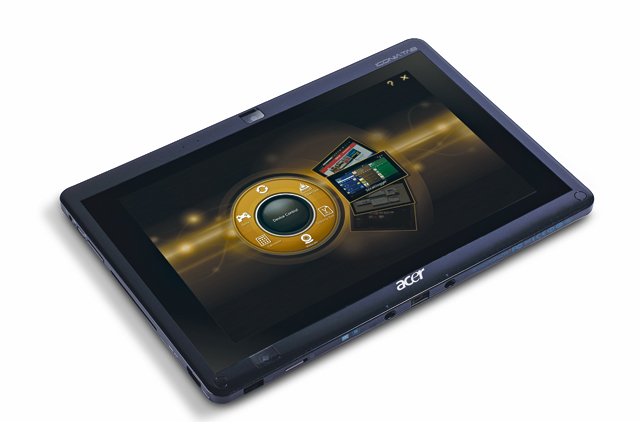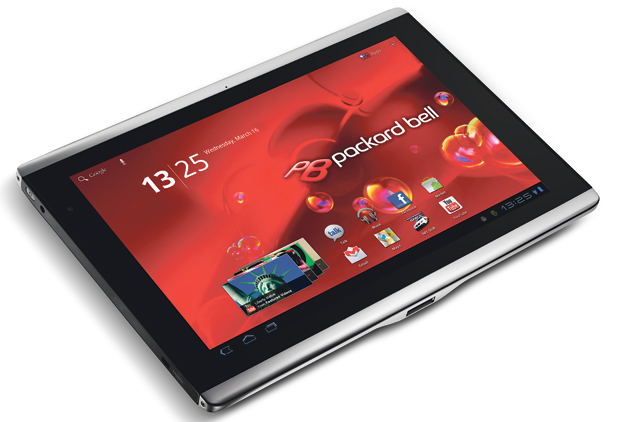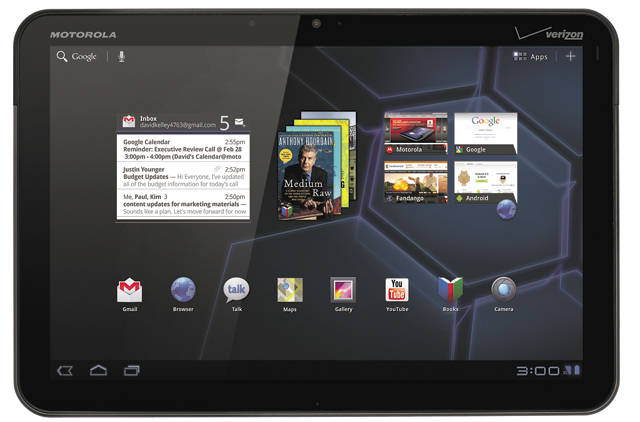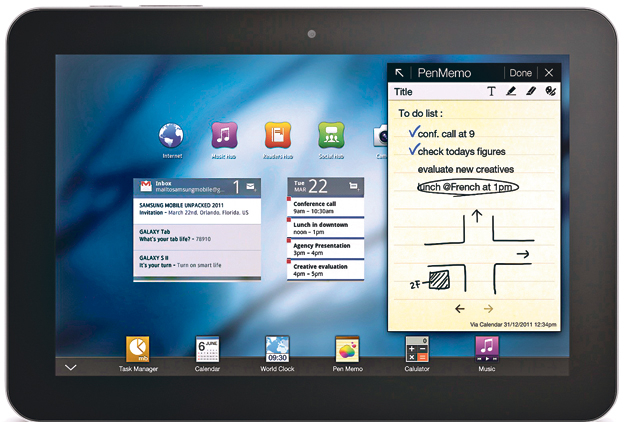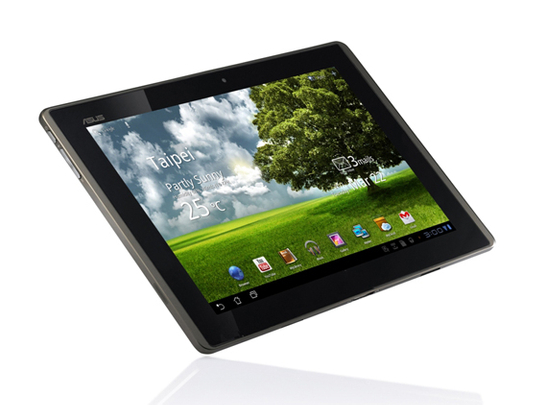
Motorola Xoom
Motorola owes it to Google. For a company fast forgotten by the masses, it has hit the jackpot by introducing the Google-created Android OS on its mobile phones and a tablet-only OS, Honeycomb in its Xoom device.
When you first hold the Xoom (we got our hands on the 32GB Wi-Fi wonder), the immediate thought is this one won't slip out of your hands that easily. When I'm buying something, the most important thing is the feel of it and Xoom fulfils that first criteria. It's not built like a tank, but with a matte back finish and solid glass in front, the feel factor is good.
Physically, its between the small and the too big (at 10.1-inch, the Xoom sits between Blackberry's seven-inch PlayBook and Asus' 12.1-inch Eee Slate EP121) and even though the form factor isn't like the iPad, it hold its own in terms of usability.
With an aspect ratio of 16:9 and 1280x800 resolution, video on the device is the best compared to other tablets. There's a front-facing two-megapixel camera for video chats and as a rear-facing five-megapixel camera that captures video in HD.
Switching between applications is fast, thanks to its dual core processor and the game experience is brilliant, with play as well as graphics. There are thousands of apps in Google marketplace, so if you need something that isn't built in, chances are the well organised Android market will have it.
As the OS evolves over a period of time and with great interest from developers the future of Android is bright and full of bloom. Unlike Apple, companies such as Google and Microsoft do not drop support for legacy systems. Meaning a Xoom bought today will run the next updates and releases of the OS in the future (fingers crossed).
The Xoom is built both for fun and for serious work: you can play games between meetings, edit documents on the go, do crosswords on the Metro ride home or grapple with Microsoft Exchange. If its your fun toy, the Xoom is also your workhorse.
There's no denying that Apple rules the tab market so deservedly, but then, life is about choice and Motorola Xoom is just that.
— A.A.
Samsung Galaxy
Some might accuse Samsung of taking its Apple fixation too far but if the result is a tablet like the new Galaxy 10.1, we aren't complaining. Keeping in mind that one of the prime reasons to own a tablet remains being seen with it, the Koreans laid special emphasis on design. It is clear the iPad was the benchmark for the 10.1 and this time the mandate for the Seoul boffins was to do one better than Apple's bestseller, at least design-wise. And so they did.
The Galaxy 10.1 is not only the best-looking tablet of this lot, it is by several accounts the best-looking in the market at present. Thinner than the iPad2, sleek and glossily finished, it screams sophistication and style. The 10-inch screen is the clearest of any tablet we have seen.
The rear is finished in glossy white plastic and the side rims look like anodised aluminium. Overall it oozes quality and even from the first time you hold it, the difference in build quality is palpable. It runs the same Android 3.0 operating system as the others but Samsung has tweaked the look and feel, especially of the user interface. Switch it on and you get a brilliant image that is the brightest and sharpest of the lot. The icons and widgets are all designed slightly differently. And better.
Coupled with Samsung's own applications, such as Memo and Mini Diary, an excellent camera and speakers that sound the most natural and realistic of the lot, the user experience of the Galaxy 10.1 is top notch.
The only grouse is that in its zeal to match the iPad's looks, Samsung fell for the Apple's minimalist, clean-cut, slightly impractical approach — which means no port or slot of any kind except for the single charging/connection socket and the 35-millimetre headphone jack. The Galaxy 10.1 is a capable performer, though it fails to touch the highs set by the Asus. As a combination of looks and performance though, it is much coveted.
— A.B.
BlackBerry PlayBook
When tablets first appeared, they were touted to fill the void between laptops and smartphones. We wanted a device that replicated the functionality of a laptop but strove toward the portability of a smartphone. The PlayBook is probably the first to justify the invention itself.
Firstly, it's the perfect size. All 0.9 pounds and seven inches of it carries like a moleskin notebook — fitting in cargo pants, a coat pocket, or your palm. The keypad's dimensions are perfect for ergonomic and efficient thumb typing, while the resolution is brilliantly sharp and the sound is highly proficient.
The PlayBook is operated through a margin around the screen — this helps as your fingers don't get in the way of browsing. With a nimble operating system, multitasking is a breeze. A dual-core 1 Ghz processor and 1GB of RAM make the PlayBook the speediest in the game. Unlike a lot of other products, its browser supports flash, while an HDMI slot at the bottom means content can be channelled to a television. The BlackBerry Bridge (downloaded from Appworld on the tablet) feature allows you to connect your BlackBerry phone to the PlayBook via Bluetooth — BBM, contacts, messages, files, essentially anything on your smartphone, which can then be accessed on the tab.
Most reviewers quip that the PlayBook should be called the ‘workbook', given that Microsoft Word, Excel and Adobe Reader are pre-installed. But this is somewhat of a curious verdict considering the most entertaining game to be found on any tablet is available on the PlayBook. Need for Speed Undercover is addictive to catastrophic proportions — a racing game where you steer with the tablet itself, which is helped by the responsiveness of the device.
Overall, this quick, crisp, minimalist piece of spaceware that can claim to serve a purpose beyond that of an ostentatious toy. It has the competence close to that of a laptop; performance wise it might be at par with one, and it is highly portable to boot. It comes closer to bridging that gap than any other slab of machinery on the market.
— F.H.
Asus Eee Pad
About an aeon ago Asus surveyed the world of computers as a genius looks at cretins. Then it unleashed its brainwave — the Eee PC — on an unsuspecting market and created history. That done, it drifted off to sleep, perhaps aided by the soporific ringing of cash registers. But now the giant has risen from its slumber and its Eee Pad Transformer is bestriding the tablet world like a colossus. If Asus invented the wheel in the form of the Eee PC, well, it just went and reinvented it in the form of the Eee Pad Transformer. And don't just take our word for it.
Asus has shipped 400,000 pieces worldwide so far this year alone, making it the best-selling non-iPad pad on the market. This popularity owes a lot to the single attachment that the Transformer ships with — a keyboard module. If there was ever a dock that has its competitors all at sea, this is it.
While some might say attaching a keyboard to a tablet is a step backwards, we say: whatever works. One use had us convinced. The Eee Pad is one of the better tablets in this group. It has the same Tegra2 CPU and 10-inch screen as the Iconia but the picture quality has most others beat. When undocked it is thin and slender, with a superbly responsive touch screen, comes with a MicroSD slot to expand its 16GB built-in storage, and a class-leading nine hours-plus of battery life.
Dock it and, besides a keyboard and mouse trackpad transforming it nearly into a conventional laptop, it gives you more memory expansion slots, an HDMI slot, three USB connectors and, best of all, another seven hours of battery life for a total of more than 16 hours on a full charge. No other portable computing device even comes close. All this and the device's dimensions still somehow remain ultra-compact. And when you factor in the value for money — it is priced at Dh1,809 without the dock and around Dh2,200 with it — it becomes the outstanding product in the class. The only grouse, if we were to nitpick, is that it takes a little practice to find the right slots when locking it into place on the dock.
— A.B.
Packard Bell Liberty
Vehicle manufacturers often ship a car built in one part of the world to another country, where they stick on a different brand, a different model name and market it as a new product. It's called badge engineering, and it fools no one.
If the Packard Bell reminds you of another tablet that's because it is a badge-engineered Acer Iconia. Packard Bell has been part of the Acer group since 2008 and after Acer launched its Iconia A500, rather than starting from scratch with the Liberty, it seems to have simply taken the Iconia and tried to disguise it. The two seem identical in every way under the surface, except that the Liberty gave us around an hour's extra battery life than the Iconia's six-and-a-half. On the surface is where most of the changes lie. Instead of the faux-brushed aluminium panel of the Iconia, the Liberty's back panel is red plastic, which is well-finished but glossy. The screen is a different one, too, and has a higher contrast ratio than the Iconia, and is better overall, though some colours looked muted.
Perhaps the most noticeable change is in the sound quality. Even though the specs do not say anything different, the Liberty's speakers give a larger volume of sound than the Iconia's. Perhaps aided by the vibrations of its plastic back panel the Liberty's sound seems to carry further, though it is tinny in quality and not as detailed as the Iconia's. TheLiberty is on the verge of being introduced into our markets and reports say it will be priced almost on par with the Iconia.
— A.B.
Acer Iconia
This may be a bitter pill to swallow for some tablet fans at a time when everyone and his uncle is simply dying to get their hands on the gadget, but this latest electronics craze is not going to replace your laptop really soon.
A major reason is the Android 3.0 operating system the Acer Iconia uses. If your needs are confined to web surfing, social networking, playing music or an occasional movie, playing graphically undemanding games and being seen with the latest gadget, the Iconia fits the bill.
The SocialJogger function, is a jog dial that puts your Facebook and Twitter accounts in one place, so you don't have to click on two icons on the starting window. Instead scroll through the feeds and stay in touch with friends with a twirl of its wheel.
Throw any heavier operations at it, such as even word processing and spreadsheets, and it stutters. And the trouble also is that this bill the Iconia fits, its rivals fit it better. For starters, the Iconia is hamstrung by its bulk and weight. It is a more than an inch thick, which in tablet-speak is enormous bulk. One would expect Acer to utilise it and, at the very least, provide a full-sized HDMI port but they have stuck to a mini version. Thankfully, there is a 3.5 millimetre headphone jack and a micro SD card slot for memory expansion, as well as a micro-USB, but only one full-size USB slot.
The 10-inch screen and five-megapixel camera are quite standard and the 6.5 hours of battery life at normal use rather meagre, but there are some plus points, notably while the superbly finished mock brushed aluminium back and fast processing power is provided by the Tegra2 CPU and 1GB of RAM.
— A.B.


